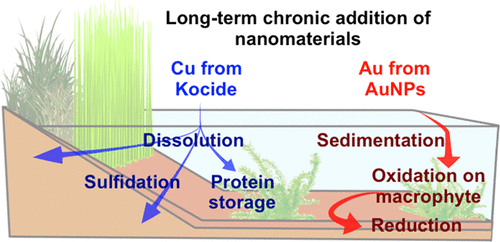当前位置:
X-MOL 学术
›
Environ. Sci. Technol.
›
论文详情
Our official English website, www.x-mol.net, welcomes your
feedback! (Note: you will need to create a separate account there.)
Differential Reactivity of Copper- and Gold-Based Nanomaterials Controls Their Seasonal Biogeochemical Cycling and Fate in a Freshwater Wetland Mesocosm.
Environmental Science & Technology ( IF 10.8 ) Pub Date : 2020-01-17 , DOI: 10.1021/acs.est.9b05097 Astrid Avellan 1, 2 , Marie Simonin 1, 3 , Steven M Anderson 1, 3, 4 , Nicholas K Geitner 1, 5 , Nathan Bossa 1, 5, 6 , Eleanor Spielman-Sun 1, 2 , Emily S Bernhardt 1, 3 , Benjamin T Castellon 1, 7 , Benjamin P Colman 1, 8 , Jane L Cooper 1, 5 , Mengchi Ho 1, 9 , Michael F Hochella 1, 10, 11 , Heileen Hsu-Kim 1, 5 , Sayako Inoue 1, 10 , Ryan S King 1, 12 , Stephanie Laughton 1, 2 , Cole W Matson 1, 7 , Brittany G Perrotta 1, 12 , Curtis J Richardson 1, 9 , Jason M Unrine 1, 13 , Mark R Wiesner 1, 5 , Gregory V Lowry 1, 2
Environmental Science & Technology ( IF 10.8 ) Pub Date : 2020-01-17 , DOI: 10.1021/acs.est.9b05097 Astrid Avellan 1, 2 , Marie Simonin 1, 3 , Steven M Anderson 1, 3, 4 , Nicholas K Geitner 1, 5 , Nathan Bossa 1, 5, 6 , Eleanor Spielman-Sun 1, 2 , Emily S Bernhardt 1, 3 , Benjamin T Castellon 1, 7 , Benjamin P Colman 1, 8 , Jane L Cooper 1, 5 , Mengchi Ho 1, 9 , Michael F Hochella 1, 10, 11 , Heileen Hsu-Kim 1, 5 , Sayako Inoue 1, 10 , Ryan S King 1, 12 , Stephanie Laughton 1, 2 , Cole W Matson 1, 7 , Brittany G Perrotta 1, 12 , Curtis J Richardson 1, 9 , Jason M Unrine 1, 13 , Mark R Wiesner 1, 5 , Gregory V Lowry 1, 2
Affiliation

|
Reliable predictions of the environmental fate and risk of engineered nanomaterials (ENMs) require a better understanding of ENM reactivity in complex, biologically active systems for chronic low-concentration exposure scenarios. Here, simulated freshwater wetland mesocosms were dosed with ENMs to assess how their reactivity and seasonal changes in environmental parameters influence ENM fate in aquatic systems. Copper-based ENMs (Kocide), known to dissolve in water, and gold nanoparticles (AuNPs), stable against dissolution in the absence of specific ligands, were added weekly to mesocosm waters for 9 months. Metal accumulation and speciation changes in the different environmental compartments were assessed over time. Copper from Kocide rapidly dissolved likely associating with organic matter in the water column, transported to terrestrial soils and deeper sediment where it became associated with organic or sulfide phases. In contrast, Au accumulated on/in the macrophytes where it oxidized and transferred over time to surficial sediment. A dynamic seasonal accumulation and metal redox cycling were found between the macrophyte and the surficial sediment for AuNPs. These results demonstrate the need for experimental quantification of how the biological and chemical complexity of the environment, combined with their seasonal variations, drive the fate of metastable ENMs.
中文翻译:

铜和金基纳米材料的差异反应性控制了它们在淡水湿地中观世界中的季节性生物地球化学循环和命运。
要可靠地预测工程纳米材料(ENM)的环境命运和风险,就需要更好地了解复杂,具有生物活性的系统在慢性低浓度暴露情况下的ENM反应性。在这里,给模拟的淡水湿地中生环境添加了ENM,以评估其反应性和环境参数的季节性变化如何影响水生系统中ENM的命运。每周将9个月添加到已知在水中溶解的铜基ENM(Kocide)和在不存在特定配体的情况下对溶解稳定的金纳米颗粒(AuNP)。随着时间的推移,评估了不同环境隔室中的金属积累和形态变化。来自Kocide的铜迅速溶解,可能与水柱中的有机物缔合,运到陆地土壤和更深的沉积物中,并与有机相或硫化物相结合。相反,Au积累在大型植物上/中,然后被氧化并随时间转移到表层沉积物中。在大型植物与AuNPs表层沉积物之间发现了一个动态的季节性积累和金属氧化还原循环。这些结果表明需要对环境的生物和化学复杂性及其季节性变化如何驱动亚稳态ENM的命运进行实验量化。在大型植物与AuNPs表层沉积物之间发现了一个动态的季节性积累和金属氧化还原循环。这些结果表明需要对环境的生物和化学复杂性及其季节性变化如何驱动亚稳态ENM的命运进行实验量化。在大型植物与AuNPs表层沉积物之间发现了一个动态的季节性积累和金属氧化还原循环。这些结果表明需要对环境的生物和化学复杂性及其季节性变化如何驱动亚稳态ENM的命运进行实验量化。
更新日期:2020-01-21
中文翻译:

铜和金基纳米材料的差异反应性控制了它们在淡水湿地中观世界中的季节性生物地球化学循环和命运。
要可靠地预测工程纳米材料(ENM)的环境命运和风险,就需要更好地了解复杂,具有生物活性的系统在慢性低浓度暴露情况下的ENM反应性。在这里,给模拟的淡水湿地中生环境添加了ENM,以评估其反应性和环境参数的季节性变化如何影响水生系统中ENM的命运。每周将9个月添加到已知在水中溶解的铜基ENM(Kocide)和在不存在特定配体的情况下对溶解稳定的金纳米颗粒(AuNP)。随着时间的推移,评估了不同环境隔室中的金属积累和形态变化。来自Kocide的铜迅速溶解,可能与水柱中的有机物缔合,运到陆地土壤和更深的沉积物中,并与有机相或硫化物相结合。相反,Au积累在大型植物上/中,然后被氧化并随时间转移到表层沉积物中。在大型植物与AuNPs表层沉积物之间发现了一个动态的季节性积累和金属氧化还原循环。这些结果表明需要对环境的生物和化学复杂性及其季节性变化如何驱动亚稳态ENM的命运进行实验量化。在大型植物与AuNPs表层沉积物之间发现了一个动态的季节性积累和金属氧化还原循环。这些结果表明需要对环境的生物和化学复杂性及其季节性变化如何驱动亚稳态ENM的命运进行实验量化。在大型植物与AuNPs表层沉积物之间发现了一个动态的季节性积累和金属氧化还原循环。这些结果表明需要对环境的生物和化学复杂性及其季节性变化如何驱动亚稳态ENM的命运进行实验量化。











































 京公网安备 11010802027423号
京公网安备 11010802027423号